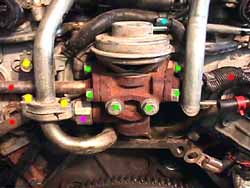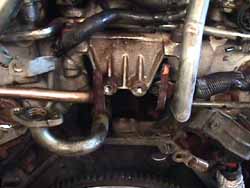EGR Removal
The EGR system is designed to introduce exhaust gas into the intake manifold--EGR stands for Exhaust Gas Recirculation. This lowers the combustion temperature to lower NOx emissions. It is a required emissions control system, and removal of it is likely all kinds of illegal. Here's how to do it!
Images originally from TTZD.com. A big thanks to the original author/photographer!
Contents
Tools Required
- Assortment of wrenches, ratchetss (10mm, 12mm and 14mm specifically). Flex heads, ratcheting wrenches, stubbies, etc are all very helpful here.
- Cutting tool (dremel tool) OR large prybar/ratchet straps.
- A lot of patience.
Parts Required
- EGR Bypass kit (available from your friendly neighborhood Z32 parts vendor).
Procedure
Removal of the EGR system is tricky, as it is in a very tight location. There are two major hiccups associated with this job:
- The bolts that hold the EGR valve to the engine are longer than the space between the EGR valve and the firewall.
- The EGR tube that connects to the driver's side exhaust manifold is extremely difficult to access.
However, there are of course tricks and work-arounds for these problems. This article will hopefully explore these tricks.
Prerequisite
You must first remove the intake manifold.
Engine-rocking Method
One common way to remove the intake manifold is performed when you have the transmission removed for another job (such as a clutch/flywheel replacement or upgrade).
- Spray all EGR bolts in PB Blaster and wait a day!
- After removing the transmission, remove the upper intake pipes (2 for the NA, 4 for the TT). This will allow more flex in the engine on its mounts.
- Remove the vacuum line from the EGR valve (blue dot below).
- Remove the side-tube EGR bolts and, as much as you can, loosen the main EGR bolts (2 x 12mm, green dots). Break the tubes loose from the EGR.

- Move the engine forward, away from the firewall, to gain more access to the EGR. Continue to loosen the EGR bolts until they're all the way out. There are two main methods I've heard of doing this:
- Putting down plenty of towels to protect the body work, run a ratchet strap from the engine (if you can find a good place to hook it onto) to a secured source, like a tree or a beam. With the parking brake in and the car in gear, ratchet the strap just enough to pull the engine forward and give you clearance to remove the bolts all the way.
- Again, using plenty of padding, use a large pry-bar between the engine and the firewall to push the engine forward and away from the firewall, giving you clearance to remove the bolts. This one will likely require a partner.
- Remove the exhaust feed tube (pink dot above) fitting with a large adjustable wrench.
- If you have trouble accessing it, remove the driver's side water pipe (yellow dots).
- Remove the exhaust feed tube fitting from the driver's side exhaust manifold. This may require removal of the brake booster to access it. If you happen to have a RHD car, removal of the battery should be sufficient.
- Remove the EGR valve.

- Remove the EGR solenoid and associated vacuum lines. Check out the Vacuum Diagrams article for a little more help seeing how this is done.
- Skip to the "Bypass Kit Installation" section below.
Bolt-Cutting Method
The other common method to removing the EGR valve is to cut the bolts at the rear of the engine.
- Spray all EGR bolts in PB Blaster and wait a day!
- Remove the vacuum line from the EGR valve (blue dot below).
- Remove the side-tube EGR bolts and, as much as you can, loosen the main EGR bolts (2 x 12mm, green dots). Break the tubes loose from the EGR.

- After loosening the main EGR bolts (2 x 12mm, two center green dots above), continue to loosen one until it's touching the firewall, but still has to come out more. Using your cutting wheel, cut the bolt about 0.5" to 1.0" from the EGR valve.
- Using vice-grip pliers, continue to remove the EGR bolt you just cut. If you it gets to the firewall again, cut some more off and repeat.
- After you get one bolt all the way out, repeat steps 4 and 5 for the other bolt. Doing one at a time allows you to have more "wiggle room" with the pliers.
- Remove the exhaust feed tube (pink dot above) fitting with a large adjustable wrench.
- If you have trouble accessing it, remove the driver's side water pipe (yellow dots).
- Remove the exhaust feed tube fitting from the driver's side exhaust manifold. This may require removal of the brake booster to access it. If you happen to have a RHD car, removal of the battery should be sufficient.
- Remove the EGR valve.

- Remove the EGR solenoid and associated vacuum lines. Check out the Vacuum Diagrams article for a little more help seeing how this is done.
- Skip to the "Bypass Kit Installation" section below.
Bypassing Without Removal
Due to tool, time, or physical restraints, it's sometimes impossible to remove the EGR system completely without removing the engine from the car. Many owners still opt to bypass the system, leaving much of it still in place but without function.
- After removing the plenum, install the plenum block plates on the underside of the plenum.
- See the "Bypass Kit Installation" section below.
- Using a cutting tool, cut the EGR tubes as far towards the back of the engine as possible. Be sure to have any pipes (turbo outlets, for example) completely covered to prevent metal shavings from entering
- Install a rubber cap (5/8"?) on what's left of the EGR tube. Use a zip-tie to secure it in place.
- If the EGR valve is functioning properly, it will actually prevent exhaust gas from flowing through these if it doesn't have a vacuum signal, but this is still good practice, just-in-case.
- Remove the EGR solenoid and associated vacuum lines. Check out the Vacuum Diagrams article for a little more help seeing how this is done.
Bypass Kit Installation
After removing the EGR system, it's quite straightforward to install the delete/bypass kit.
- Install the plenum block plates on the underside of the plenum, using the included gasket. Snug the bolts down to 6.2-8 lb-ft.
- Using some high-temp anti-seize on the threads, install the manifold block-plug into the driver's side exhaust manifold. Torque to 25-33 lb-ft.
- Remove the EGR solenoid and associated vacuum lines. Check out the Vacuum Diagrams article for a little more help seeing how this is done. Most delete kits also include a vacuum nipple and zip tie, which can be used to block the vacuum port which used to run to the EGR solenoid from under the passenger side throttle body.